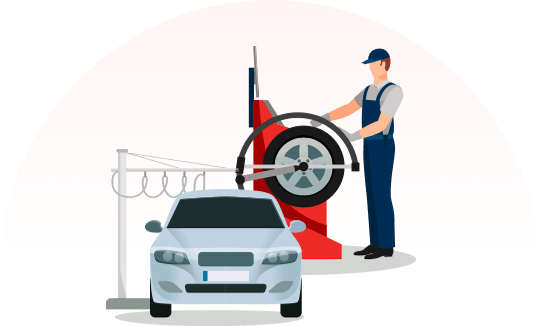- 8 Sep 2024
How Proper Wheel Alignment Prevents Uneven Tyre Wear

Understanding Wheel Alignment
Wheel alignment is all about making sure your car’s wheels are pointing in the right direction. It’s like making sure your car’s shoes are on straight! When your wheels are properly aligned, they work together to move your car smoothly down the road.
Key components involved in alignment
There are a few important parts that play a role in wheel alignment:
- Suspension system
- Steering components
- Tyres and wheels
These all work together to keep your car rolling straight and true.
Signs of misaligned wheels
Your car might be trying to tell you something if you notice:
- Your steering wheel is off-center when driving straight
- The car pulls to one side
- Uneven or rapid tyre wear
- Squealing tyres
If you spot any of these signs, it might be time for an alignment check!
How Misalignment Causes Uneven Tyre Wear
Increased friction and heat generation
When your wheels aren’t aligned properly, it’s like they’re fighting against each other. This creates extra friction, which leads to heat. And just like how rubbing your hands together makes them warm, this extra heat can wear out your tyres faster.
Specific wear patterns and their causes
Different alignment issues cause different wear patterns:
- Edge wear: Often caused by camber problems
- Feathering: Usually due to toe misalignment
- Center wear: Can be from over-inflation, but also alignment issues
Spotting these patterns can help you figure out what’s wrong with your alignment.
Impact on tyre performance and safety
Misaligned wheels don’t just wear out your tyres faster – they can also make your car less safe to drive. Uneven wear can reduce your tyres’ grip on the road, making it harder to control your car, especially in wet or slippery conditions.
Benefits of Proper Wheel Alignment
Extended tyre lifespan
When your wheels are properly aligned, your tyres wear evenly. This means they’ll last longer, saving you money in the long run. It’s like making sure you wear your shoes evenly so they don’t wear out on one side!
Improved fuel efficiency
Misaligned wheels can make your car work harder to move down the road. When everything’s lined up right, your car doesn’t have to fight against itself, which means it uses less fuel. It’s a win for your wallet and the environment!
Enhanced vehicle handling and stability
Proper alignment helps your car drive the way it was designed to. You’ll notice it feels more stable, especially when you’re turning or driving at higher speeds. It’s like the difference between walking straight and trying to walk with your feet pointed in different directions!
Maintaining Proper Wheel Alignment
Recommended alignment check intervals
Most mechanics suggest getting your alignment checked every 12,000 to 15,000 miles or at least once a year. But if you hit a big pothole or notice any of the signs we talked about earlier, it’s a good idea to get it checked sooner.
Factors that affect wheel alignment
Several things can knock your wheels out of alignment:
- Hitting potholes or curbs
- Getting into a fender bender
- Normal wear and tear on suspension parts
- Carrying heavy loads frequently
Professional alignment vs. DIY methods
While there are some DIY methods to check your alignment, getting a professional alignment is usually the best bet. They have specialized equipment that can measure and adjust your alignment with precision. It’s like the difference between eyeballing a crooked picture frame and using a level to get it just right.
The Role of Tyre Rotation in Preventing Uneven Wear
Purpose of tyre rotation
Tyre rotation is like giving your tyres a chance to walk in each other’s shoes. By moving them to different positions on your car, you help them wear more evenly. This works hand in hand with proper alignment to keep your tyres in good shape for longer.
Recommended rotation patterns
The best rotation pattern depends on your car and tyres. For front-wheel drive cars, a common pattern is moving the front tyres to the back and the back tyres to the front, crossing them as they go. Your car’s manual or a tyre professional can tell you the best pattern for your specific vehicle.
Frequency of tyre rotation
Most mechanics recommend rotating your tyres every 5,000 to 8,000 miles. But if you notice uneven wear or your car manual suggests a different interval, it’s best to follow that advice.

 Google Review
Google Review 




 Google Review
Google Review
 Digitally enhanced by
Digitally enhanced by